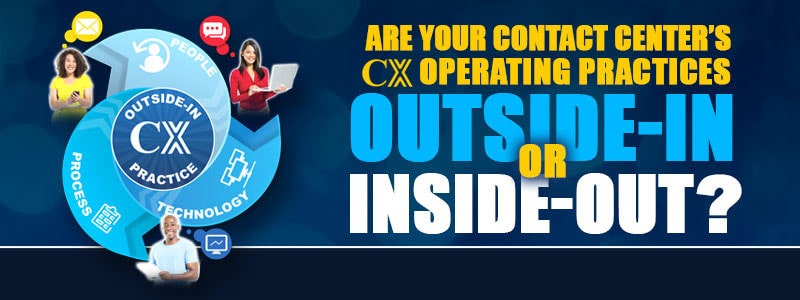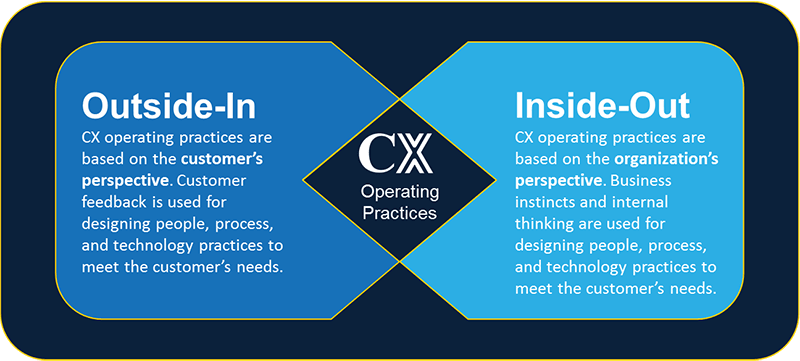
Outside-In or Inside-Out CX Operating Practices
Outside-In or Inside-Out?
SQM’s CX research data reveals that 92% of contact center executives agree that improving customer experience (CX) is essential. However, given management’s struggle to accurately assess, identify opportunities to improve CX, and deliver a great CX, we thought it would be helpful to share SQM’s experience about the differences between Outside-In and Inside-Out CX operating practices.
CX operating practices guide decision-making to create and improve people, processes, and technology to meet or exceed the customer’s needs.
CX operating practices can be an Outside-In or an Inside-Out approach. The difference is the Outside-In CX operating practices are based on the customer’s perspective. Conversely, the Inside-Out CX operating practices are based on the organization’s perspective.
Many contact center managers believe that their primary CX operating practices are an Outside-In approach. However, based on SQM’s extensive experience evaluating organizations’ CX operating practices, we believe that only 25% of organizations use Outside-In CX operating practices. In reality, most organizations are somewhere between the Outside-In and Inside-Out CX operating practices with a high skew (75%) towards Inside-Out.
CX Operating Practices

Inside-Out CX Operating Practices
The essence of the Inside-Out CX operating practice is based on the organization’s perspective. Business instincts and internal thinking are used for designing people, processes, and technology methods to meet the customer’s needs.
An internal focus on managing and improving First Call Resolution (FCR) and CX can be beneficial, but improving CX is less likely without customer feedback. SQM’s extensive research and experience show that most decisions on managing or improving CX are heavily based on employee instincts and internal thinking.
The downside with primarily using instincts and internal thinking for managing and improving CX is that, in most cases, decisions are mainly influenced by personal biases, assumptions, groupthink and are not based on CX feedback.
It has also been SQM’s experience that many managers exaggerate or are over-confident about the organization’s people, processes, and technology efforts in which they have participated.
As a result, managers can lose their objectivity and be very defensive, especially if a viewpoint is different from theirs, even if it is a customer’s perspective.
Another challenge is that some managers think they are the smartest people in the room. Therefore, they are not interested in the customer perspective because they believe they know more about its products and services than customers.
Common Inside-Out CX Operating Practices:
- Internal metrics such as QA, service level, and internal FCR are the key metrics used to determine the quality of CX (e.g., CX quality is defined by the organization)
- Expand customer base by making a high investment in marketing initiatives
- People, processes, policy, and technology practices focused on organization needs
- Push products/services into market approach versus needs-based selling approach
- High emphasis on efficiency and lowering cost, often at the expense of a positive CX
- Tendency to mimic competition (e.g., good and bad CX practices)
It should be stated that SQM has a few clients that we would describe as having an Inside-Out operating practice that provides great CX. However, this is the exception to the rule. However, these contact centers successfully delivered a positive CX because the leaders of these contact centers have great CX instincts and conduct some CX research; they are passionate about what they do, effective at internal reporting, good technology, and processes.
Many managers believe that if you work hard at delivering positive CX, you will eventually become great at consistently delivering positive CX. That might be true. But, how do you ever know if you never ask your customers?
To underscore the need for CX feedback, in most cases, managers think their CX is higher than how their customers rate it. Furthermore, the contact center management team was passionate about delivering a positive CX.
The essential point is when you think your CX is good or great, the chance of you wanting to improve CX is not likely, or if you do make changes and do not seek out customer feedback, you will never really know your actual CX performance or if it has improved. Therefore, it is paramount that organizations that use the Inside-Out practice, at a minimum, gather annual customer feedback from a credible third-party CX research firm
Outside-In CX Operating Practices
The essence of the Outside-In CX operating practice is based on the customer perspective. Customer feedback is used for designing people, processes, and technology practices to meet the customer’s needs.
The Outside-In CX operating practice requires the organization to be customer-centric. Organizations using this approach incorporate customer feedback into all aspects of their operating practices.
With the Outside-In CX operating practice, the customer defines CX. With the Inside-Out CX operating practice, the organization defines CX. Arguably, the Outside-In CX operating practice is the better of the two CX operating practices.
Most frontline customer interfacing employees prefer the Outside-In CX operating practice and want the C-level to commit to this practice. In other words, frontline employees are not the obstacle for the Outside-In CX operating practice; rather, the obstacle is at the C-level.
It is essential to state that when SQM examined the organizations that were in the good to world class CX performance level, the majority of them have an Outside-In CX operating practice.
There is much debate on whether an organization should have a shareholder or a customer value focus. SQM’s viewpoint is that if a customer value (Outside-In) focus is executed correctly, it will increase profits and therefore increase shareholder value. Conversely, having a shareholder value (Inside-Out) focus can lead to short-term thinking on people, processes, and technology practices that can be to the detriment of a positive CX.
Common Outside-In CX Operating Practices:
- Seeks customer feedback using different listening posts (e.g., surveys, social media, focus groups, interviews)
- External metrics such as first contact resolution, one contact resolution, customer emotion experience, and customer loyalty are the key metrics being used to determine the quality of CX (e.g., the customers define CX quality)
- Making investments in customer loyalty improvement initiatives
- High emphasis on providing positive CX and maximizing benefits for the customer
- Improve pain points that are hindering a positive CX
- People, process, policy, and technology practices are based on customer feedback
It has been SQM’s experience that most organizations struggle with CX strategy design and execution. Most organizations state that they have a formal or informal enterprise-wide CX strategy design. However, most CX strategy design and execution efforts fail or do not meet the organization’s expectations.
Clearly, CX strategies with poor design and execution lead to lower Csat, customer referrals, and retention. Therefore, to improve CX, organizations need a CX strategy that accurately evaluates CX, has an effective CX design, and, most importantly, has a CX strategy design that is properly executed.
There have been many stimulating discussions about future CX practices at the C-level and contact center senior executive level. These discussions tend to focus on the importance of letting the customer choose the contact channel they prefer, adding new contact channels, improving specific contact channel FCR performance, differentiating CX from the competition, providing consistency among contact channels, and providing an omni-channel CX.
Discussions about future decisions for CX practices are being driven by today’s connected customer and their expectations on how they want their interactions with an organization to be handled. For example, customers’ adoption of digital contact channels and their expectations to have a seamless customer experience resolving the same inquiry or problem when using multiple contact channels have forced senior executives to rethink their CX operating practices.
SQM recommends using the below CX operating practice steps to assist organizations in implementing an Outside-In CX operating practice. Also, these steps can be used for assessing your organization’s Outside-In CX operating practice. There are three essential steps (i.e., evaluating, designing, and executing) to develop an Outside-In CX operating practice.
These steps were developed based on SQM’s extensive experience in helping organizations’ contact centers utilize best practices for improving CX and providing world class CX. Therefore, the Outside-In CX operating practice should be viewed as an ongoing closed-loop (i.e., evaluating, designing, and executing) CX improvement process. The following are the three essential steps and corresponding sub-steps for an effective Outside-In CX operating practice:
The first step is evaluating the CX, which entails utilizing customer survey feedback, focus group feedback, CX journey mapping, and internal data information to evaluate CX. The primary goal of this step is to understand what customers expect, determine whether the organization is meeting those expectations, and provide opportunities for improving CX when customers interact with an organization using a contact channel to resolve an inquiry or problem. The VoC needs to be incorporated in all three steps (i.e., evaluating, designing, and executing) of the Outside-In CX improvement process.
The second step is designing the CX, which entails defining the CX you want to deliver and what customers expect when they interact with your organization, operationalizing and prioritizing resources, and the operating principles to deliver the intended CX. The primary goal of this step is to share CX feedback from step one and ensure it is being used for designing CX. Designing CX is guided by operating principles such as reducing customer effort, taking ownership for resolving an inquiry or problem, making it a positive CX, and doing what is best for customers. SQM research shows that of the three steps, organizations struggle the most with designing CX.
The third step is executing the new CX, which entails communicating the new CX design, measuring success, creating accountability, and rolling out the new CX initiatives. The primary goal of this step is to conduct a test pilot for a new CX design to validate that the initiatives met or exceeded the intended CX design before fully implementing it to the entire organization or contact center. In addition, the test pilot step allows you to make changes to the new CX design to ensure success and to develop standard operating procedures for the new CX design to assist in rolling out enterprise-wide.
If you are interested in learning more about the differences between Outside-In and Inside-Out CX Operating Practices to improve FCR, Csat, increase customer referrals, and retention, please contact SQM.
Quick Related Links
First Call Resolution Definition First Call Resolution PPT First Call Resolution Benefits
First Call Resolution Strategies First Call Resolution Operating Philosophy FCR Case Study Survey Data Calculate First Call Resolution Rate Five Benefits of Journey Mapping CX Pulse Check Top 10 CX Metrics VoC Closed-Loop Journey Mapping FCR Strategy Options
